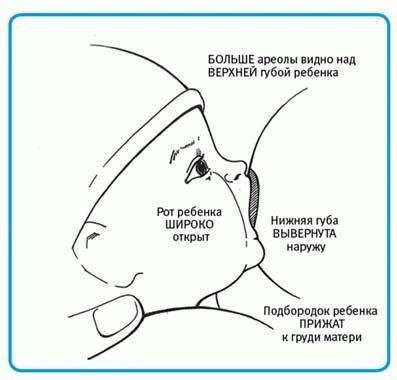Completion of breastfeeding occurs individually for each woman. If this cannot be done naturally, then mothers resort to the use of medications. Experts often recommend Dostinex for lactation, a dopaminomimetic that is a derivative of ergot alkaloids.
Dostinex is one of the most popular drugs for medical cessation of lactation.
The effect of the hormone prolactin during hepatitis B
Breastfeeding is a complex physiological process that performs several basic functions - proper nutrition of the child, protection against infections, restoration of the woman’s body after childbirth.
An important role in milk production is played by the hormone prolactin, which takes part in stimulating the secretory apparatus of the milk ducts and stabilizes the level of milk in the mammary glands. In the first day after the birth of a child, the amount of prolactin in a woman’s blood decreases, and after 2-3 weeks the levels return to normal. However, in the mammary glands the level of the hormone remains elevated, which ensures the necessary milk production.
If a situation arises where you need to “forcibly” interrupt lactation, then the drug Dostinex will help with this.
Description and principle of action of the drug
The drug Dostinex suppresses the production of the hormone prolactin, which is responsible for the secretion of milk in the mammary glands. Lactation with Dostinex can be stopped at any time after childbirth.
The medicine is also used for hormonal disorders, when high levels of prolactin make it impossible to get pregnant, or when benign tumors appear.
The drug is produced in white tablets, packaged in bottles of 2 and 8 pcs. For ease of separation there is a notch. Priced from 650 to 1700 rubles. The active element of the drug is cabergoline, additional components are lactose and the amino acid leucine.
The drug acts immediately after use, after 30 minutes the amount of milk production in the glands decreases, after 2-3 hours the level of prolactin in the blood decreases. The effect is cumulative, the effect of the medicine lasts about 3 weeks.
If, after finishing taking Dostinex, for one reason or another, a woman decides to continue breastfeeding, then the doctor may recommend taking a reduced dose of the drug and at the same time regularly pumping to maintain prolactin levels.

Click here
How to restore lactation after taking pills?
There are situations when circumstances force a woman to stop milk production only for a while.
In cases where lactation was completed by taking medications, breastfeeding should be postponed for a month. During this period, the hormonal drug that blocks lactation and acts on a certain area of the brain will cease its prolonged action, and the body will be rebuilt for the previous mode of operation. Dostinex will no longer be detectable in the blood within a month after discontinuation, which means it will not be able to pass through breast milk to the baby.
Resuming breastfeeding is not an easy, but feasible task for every mother who wants to feed her child breast milk. How should a woman act correctly so that the process of restoring lactation (relactation) is successful?
From a physiological point of view, lactation is ensured by the hormone prolactin. In order for the body to produce it in sufficient quantities to breastfeed the baby, it is necessary to put the baby to the breast as often as possible.

If the baby is unaccustomed to drinking mother's milk and, when trying to put it to the breast, requires a bottle of milk formula, you should establish psychological contact with the child. It is necessary to take the baby in your arms as often as possible, lean it against your chest, so that the child can physiologically feel the mother’s smell and warmth.
The process of getting your baby used to the breast may take some time (sometimes several weeks). The main thing in such a situation is to believe in the success of future lactation and not stop at trying to restore it. At the same time, bottle-pacifiers and pacifiers are completely excluded, and the baby is fed with a spoon.
Weaning to the breast must be accompanied by proper attachment of the child. So, the peripapillary area of the chest should be completely captured by the child’s mouth, and the chin should be pressed tightly against it. This will ensure a complete outflow of milk from all its areas, eliminating possible lactostasis (stagnation of milk in the glands) and cracks in the nipples in the future.

At the same time, the mother should pump. This is a necessary procedure carried out in order to restore the lost ability to feed the baby with breast milk. Even if there is very little milk, expressing a couple of drops of it will not hurt, but will only provoke additional production.
As soon as a woman notices that the lactation process is gradually improving, the baby drinks breast milk and is saturated with it, it is necessary to take measures to increase the production of breast milk in accordance with the needs of the growing child's body. The following recommendations should be followed:
- Feed your baby on demand.
- Even if the baby does not require milk, apply it to the breast, including at night.
- Gradually limit the amount of supplementary feeding with formula milk, but at the same time monitor the degree of saturation (you cannot underfeed or overfeed).
Video: How to increase your breast milk supply
If, despite all attempts to establish lactation, milk does not come or is produced in very small quantities, it is possible to use lactogenic drugs (tablets, teas to increase lactation), use hardware treatment methods, and massage techniques.
Dostinex in pharmaceuticals is recognized as a modern, effective and relatively safe drug that can help a woman prevent the production of breast milk. Of course, its use should be due to compelling objective reasons and monitored by the attending physician. If, after taking the pills, it is possible and necessary to restore lactation, this is possible. The main thing is to understand the benefits of breastfeeding and believe in its success.
Sources
- https://RebenokEst.ru/gv/zavershenie-gv/dostineks
- https://kcdc.ru/aptechka/dostineks-kak-pravilno-prinimat.html
- https://orebenke.info/posle-rodov/laktatsiya/dostineks-instruktsiya-po-primeneniyu.html
- https://UpBaby.ru/mama/lechenie-mamy/dostineks-instrukciya-po-primeneniyu-dlya-prekrashheniya-laktacii
- https://www.rlsnet.ru/tn_index_id_7776.htm
- https://www.neboleem.net/dostineks.php
- https://grudnichky.ru/mamam/dostineks-dlya-prekrashheniya-laktatsii.html
- https://VseProRebenka.ru/laktaciya/opyt/dostineks-instrukciya-dlya-prekrashcheniya-laktacii.html
Indications for taking Dostinex
The medicine is produced according to a doctor's prescription, and a dosage regimen is prescribed according to specific indications. The drug Dostinex is used to suppress lactation in certain cases:
- stopping breastfeeding for medical reasons;
- mother's refusal to breastfeed;
- after an abortion;
- in case of menstrual irregularities;
- for benign breast diseases;
- with polycystic ovary syndrome.
The drug Dostinex has a mild effect, is easily absorbed from the intestines, excreted by the kidneys, and in rare cases causes side effects. The dosage is prescribed by the treating doctor.
Features of the correct dosage
To suppress lactation, Dostinex is taken according to the following therapeutic regimen: 4 doses of 0.25 mg for 2 days every 12 hours.
If lactation has not yet begun, then a single dose of 1 mg is taken the day after birth. If there is an excessive amount of prolactin in the blood, take 1 tablet per week or divide the intake into 2 times, half a tablet 2 times a week.
You may need an individual dosage if you are taking additional medications or biological supplements that can reduce the effect of the main element of Dostinex.
It is important not to exceed the dose prescribed by the doctor, and if there is no result, then consult a specialist again and undergo additional examination. The maximum number of tablets per week is 9 pieces, which is 4.5 mg of cabergoline.
It is forbidden to feed a child while taking the drug, so as not to expose the fragile body to unreasonable risk. During this period, you need to create a comfortable environment for him in order to avoid the negative impact of the stress factor on the baby.
Cabergoline should not be used simultaneously with macrolide antibiotics, such as Erythromycin.
According to the advice of Dr. Komarovsky, it is best to take the drug on the weekend so that the family can be with the child. The risk of dizziness in the mother increases as blood pressure decreases. She is shown peace and a favorable atmosphere in the house.

Self-medication with medications can cause serious side effects. Before using Dostinex, you should definitely consult your doctor.
Pharmacodynamic and pharmacokinetic properties
By its nature, the active substance belongs to dopaminergic derivatives of ergoline. It has a prolactin-lowering effect due to a direct effect on D2-formin receptors, which are located in the pituitary gland. In addition, if the dose was increased in order to reduce the amount of prolactin in the blood serum, the active substance of the drug may acquire the ability to influence central dopamirgenes.
A significant decrease in prolactin occurs three hours after taking the drug, and the effect will last up to 28 days in women with hyperlactonemia. For women in the postpartum period, the drug is effective for three weeks.
A positive property of the active substance is that it affects the production of only prolactin, and it does not affect other hormones at all. The effect of lowering this hormone depends on the dose received and the duration of use of Dostinex.

After entering the body, Dostinex is absorbed in the digestive system and the active substance can be detected in the blood plasma within half an hour after the start of administration. Bioavailability is 42%.
The drug is eliminated from the body through urine and the time may vary, for example:
- In healthy women – up to 68 hours
- in women with hyperlactonemia – up to 115 hours
After ten days of taking Dostinex, the active substance can be detected not only in urine, but also in feces and the percentage will be 18% and 72%, respectively. An interesting fact is that the active substance can be detected in a urine test if taken daily and the dose is 2% of the original amount.
You do not need to eat anything while taking this medicine as this does not affect the absorption of cabergoline, but it is recommended that you do so with food.
Contraindications
The medicine is not used in case of individual sensitivity to the cabergoline component. And also for fibrous lesions of the lungs, retro-abdominal space, hypertension, renal failure, diseases of the vegetative-vascular system, hormonal disorders, under the age of 16 years.
If you overdose or take the medicine incorrectly, side effects are possible:
- nausea;
- vomit;
- weakness;
- tremor of the limbs;
- sleep disorder;
- dizziness, up to loss of consciousness.
The drug has a direct effect on a woman’s hormonal background, and therefore, when planning conception, it is important to stop taking Dostinex a month before fertilization.
If conception occurs during treatment, then you need to stop taking the medication and notify the gynecologist in order to minimize the negative impact of the medication on the development of the fetus.
Is it necessary to pump when stopping lactation with Dostinex?
The active substance cabergoline accumulates in the body, gradually reducing the effect of the hormone prolactin. The question often arises whether it is necessary to express breast milk after taking Dostinex.
It will not be possible to completely avoid this process, especially if the glands become rough, thickening and pain on palpation occur. You need to pump even through the pain, but just do not put the baby to the breast.
There is no need to completely empty the mammary glands, but only to eliminate discomfort. To relieve pain, it is recommended to take Nurofen or No-shpa. Perform the pumping procedure under a warm shower, then apply a cold compress to the breast.
Indications for use
Unfortunately, nature is not always favorable to couples who want to become parents. Before a baby appears in the family, the spouses have to go through a number of difficult tests - the desired pregnancy can end in miscarriage or spontaneous abortion. Sometimes the cause is organic, but most often it is due to hormones.
An excess of prolactin can not only provoke a disruption of the monthly cycle, but also lead to amenorrhea, which makes pregnancy impossible. What kind of feedback did Dostinex receive when planning from women who tried this therapy?
The active ingredient, Cabergoline, is a derivative of ergot alkaloids that stimulates dopamine D2 receptors in the lactotropic cells of the pituitary gland, thereby reducing the excessive production of growth hormone and prolactin. The content of prolactin circulating in the blood, brought to normal thanks to Cabergoline, leads to an increase in the concentration of estrogen, which in turn ensures the timely release of lutropin in the middle of the menstrual cycle, which means that all conditions are created for the onset of normal ovulation.
In addition, the use of Dostinex tablets by women reduces hypoestrogenic and hyperandrogenic manifestations, such as: water retention in the body, excess body weight, osteoporosis, hirsutism and acne.
In men, Carbegoline increases the concentration of testosterone, enhances libido, increases erection, and shortens recovery periods between sexual intercourse.

Considering the pharmacokinetics and pharmacodynamics of Dostinex, women are prescribed it for:
- soft cessation of physiological lactation;
- preventing the production of breast milk after an abortion or unsuccessful delivery;
- cessation of lactation in case of contraindications to breastfeeding;
- treatment of infertility associated with hyperprolactinemia and irregular menstrual cycles;
- treatment of galactorrhea not associated with breastfeeding;
- complex therapy for empty sella syndrome;
- treatment of prolactinsecteritizing pituitary adenoma.
In addition, Dostinex can be prescribed to reduce the side effects of steroid hormonal drugs, as it reduces gynecomastia, arterial hypertension, and inhibits the development of acromegaly.
Dostinex's analogs
If Dostinex, for objective reasons, cannot be used by a woman to stop milk production, then you can try its analogues (the choice and dosage is made by the attending physician).
Popular analogues:
- Bromocriptine - has a similar effect and is also used to treat infertility. The price is several times cheaper than Dostinex.
- Agalates is an identical active ingredient, but there are more side effects and contraindications. In case of an overdose, constipation, exacerbation of chronic gastritis, drowsiness, and vascular spasms are possible.
- Bergolak - there is no significant difference between the drugs, the composition is the same for different manufacturers.
- Bromcamphor - the effect of prolactin decreases slowly, with no side effects. The main substance of the drug is bromine.
- Parlodel - used to restore the menstrual cycle, control prolactin in a woman’s body. Reduces the volume of malignant tumors.

even if lactation had to be completed for some reason, the mother will give the child equally important and valuable attention, love and care.
Dostinex is used to prevent or stop the lactation process; the active substance, cabergoline, is characterized by a pronounced prolactin-lowering effect. Taken orally in tablet form, it is quickly absorbed from the gastrointestinal tract. It is prescribed by a doctor and, when used correctly, minimizes the risk of complications when suppressing lactation.
Contraindications and side effects when using Dostinex
Any drug has contraindications and Dostinex is no exception. The main ones are:
- Hypersensitivity to any of the components of the drug, as well as to Sporina alkaloid
- prohibited for children who have not reached puberty, namely sixteen years of age
The drug is also prescribed with great caution to people who have:
- Arterial hypertension formed during pregnancy, in this case Dostinex is prescribed only if the benefits of taking it greatly outweigh any possible risks
- Raynaud's syndrome
- severe forms of various diseases of the cardiovascular system
- for bleeding in the digestive system
- peptic ulcer
- in severe liver failure, it is recommended to prescribe the lowest dose while taking the drug
- for severe cognitive and mental disorders
- when the function of the heart muscle, as well as the respiratory system, changes due to fibrous changes that can occur in the body
- together with drugs that have a hypotensive effect, since there is a risk of orthostatic hypotension.

During treatment with Dostinex, it is forbidden to increase the dosage on your own, as this may lead to an overdose of the active component. This condition is characterized by nausea, which gradually progresses to vomiting, psychosis and hallucinations, orthostatic hypotension, and confusion.
If these signs begin to appear, then it is necessary to immediately carry out a set of procedures that will facilitate the rapid removal of the active substance from the body. To do this, it is necessary to rinse the stomach and maintain blood pressure, because while taking Dostinex it may decrease. This also includes drug treatment and in this case dopamine antagonists are prescribed.
While taking Dostinex, various side effects may occur, which must be treated with great care and they can manifest themselves in various organs of the human body. These include:
- Increased heart rate and orthostatic hypotension, as well as a gradual decrease in blood pressure in the first days of the postpartum period - from the cardiovascular system
- severe headache, which may be accompanied by dizziness, depression, fatigue, drowsiness, fainting - from the central nervous system
- nausea leading to vomiting, constipation, diarrhea, stomach pain and gastritis - from the gastrointestinal tract
- mammalgia
- unexplained flushing of the face
- nosebleeds
- leg cramps
- spasms in fingers

As a rule, all side effects occurred in only 14% during the first two weeks of starting the drug, but then they gradually disappeared.











